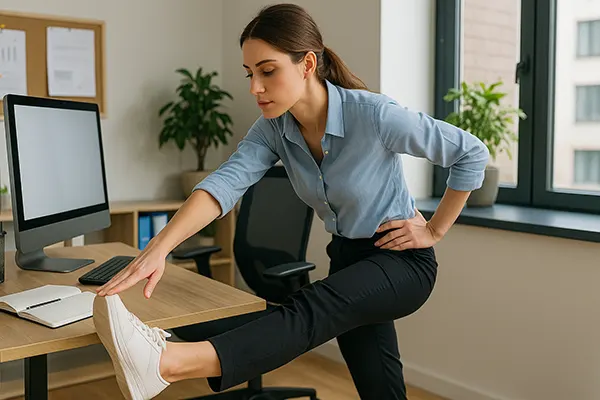
Physical Health During Office Work: Microactivity Every 30 Minutes
Modern office work involves long hours of sitting, often without significant physical activity. This sedentary lifestyle has become one of the leading risk factors for various chronic diseases, affecting not only the physical well-being of employees but also their productivity and mental health. Incorporating microactivities into the daily routine every 30 minutes has proven to be an effective and realistic method to counteract these negative effects. These short exercises help improve blood circulation, reduce musculoskeletal strain, and promote overall vitality during work hours.
Why Regular Movement Matters During Desk Work
Sedentary behaviour is associated with numerous health risks, including cardiovascular disease, obesity, type 2 diabetes, and musculoskeletal disorders. According to the World Health Organization, sitting for more than eight hours a day without regular movement significantly increases the risk of premature death. In office environments, employees can often remain seated for extended periods without realising the toll it takes on their bodies. Regular breaks for microactivity can serve as an accessible solution for breaking this pattern.
Microactivity refers to short, low-intensity movements performed for 1–3 minutes every half an hour. These can include stretching, walking to the printer, neck rolls, or light squats. The idea is not to engage in intense workouts but to introduce gentle motion that prevents stiffness, supports joint flexibility, and encourages metabolic activity. Over time, these seemingly small efforts contribute significantly to long-term health preservation.
Scientific studies conducted in 2024 by the University of Cambridge demonstrated that microactivities every 30 minutes during desk jobs reduce lower back pain by up to 32% and increase energy levels by 15% compared to a control group without movement breaks. These results underline the importance of integrating physical variation into desk-bound routines to improve health outcomes sustainably.
Physiological Impact of Microactivity
Short bursts of activity stimulate blood flow, which improves oxygen delivery to muscles and organs. This circulation boost helps reduce swelling in the legs, prevent blood clots, and reduce pressure on the spine. Additionally, frequent movement lowers cortisol levels, contributing to stress reduction and mental clarity.
Engaging in regular microactivity also supports metabolic function. Extended sitting can lead to insulin resistance, but studies show that even brief muscle engagement increases glucose uptake, supporting better blood sugar regulation. As a result, employees who practice microactivity often experience better energy regulation and fewer concentration lapses.
Moreover, microactivity breaks benefit posture. They allow for spinal realignment and relieve pressure on key joints, including hips and shoulders. Workers who adopt this habit consistently report reduced incidence of chronic pain, particularly in the lumbar and cervical regions.
Practical Implementation in the Workplace
Incorporating microactivity does not require gym facilities or specialised equipment. The focus should be on building a routine. Setting alarms every 30 minutes or using apps like “Stretchly” or “Workrave” can help remind employees to move. Employers can support this initiative by encouraging a culture where regular movement is normalised and not perceived as time-wasting.
Examples of office-friendly microactivities include standing leg curls, shoulder rolls, wrist rotations, or walking during short calls. Teams may also adopt group movement breaks where everyone stretches together, which promotes both health and social bonding. Even subtle movements such as ankle circles under the desk or seated torso twists offer measurable benefits.
Creating movement zones in offices can serve as another step forward. These are areas equipped with mats or balance boards where employees can perform quick exercises during their breaks. While optional, such spaces reinforce the importance of integrating motion and may inspire less active colleagues to participate.
Overcoming Common Obstacles
Despite the known benefits, some workers struggle with consistency. Common reasons include high workloads, fear of judgement, or simply forgetting. Overcoming these barriers requires mindset change. Emphasising the health value of short breaks and educating staff about their long-term impact can improve adherence.
Leaders and managers play a key role in modelling behaviour. When senior staff regularly take microbreaks and remain active, it creates a trickle-down effect across the team. Open discussions about the importance of microactivity help dismantle workplace taboos around movement and encourage transparency in self-care strategies.
Gradual habit-building is more effective than rigid scheduling. Encouraging each employee to find what movement suits them — be it stretching, pacing, or using a standing desk — helps create a personalised and sustainable approach to staying physically engaged at work.

Long-Term Benefits for Employees and Employers
Employees who integrate microactivity into their daily schedule experience long-term benefits such as reduced risk of chronic disease, better musculoskeletal health, and improved energy levels. These factors directly contribute to fewer sick days and enhanced workplace satisfaction. In the long term, companies benefit from lower absenteeism and reduced health insurance costs.
From a psychological perspective, movement positively affects mood and mental clarity. Incorporating regular microactivity can help counter symptoms of anxiety and burnout, which are increasingly prevalent among office workers in 2025. Physical engagement also improves sleep quality, which further enhances daytime performance and emotional resilience.
Companies that promote a culture of movement gain a reputation as progressive and health-conscious employers. This can enhance employee retention and attract top talent. In a competitive job market, prioritising employee well-being through simple, science-backed interventions like microactivity can be a strategic advantage.
Supporting Tools and Monitoring Progress
Wearable devices like smartwatches and fitness bands can track activity levels and remind users to stand up. Some even include guided stretching prompts. These tools not only improve compliance but offer data to help users assess their movement patterns and adjust accordingly.
Managers can introduce gamified wellness challenges such as weekly step goals or “movement bingo” cards. This introduces a fun, competitive element to staying active and helps reinforce behavioural change through positive reinforcement. Team-wide participation fosters a sense of camaraderie.
Ultimately, success lies in consistency. Keeping movement enjoyable, varied, and accessible allows individuals to sustain the habit beyond novelty. Employers who invest in microactivity education and infrastructure set the foundation for a healthier, more resilient workforce in the digital age.
